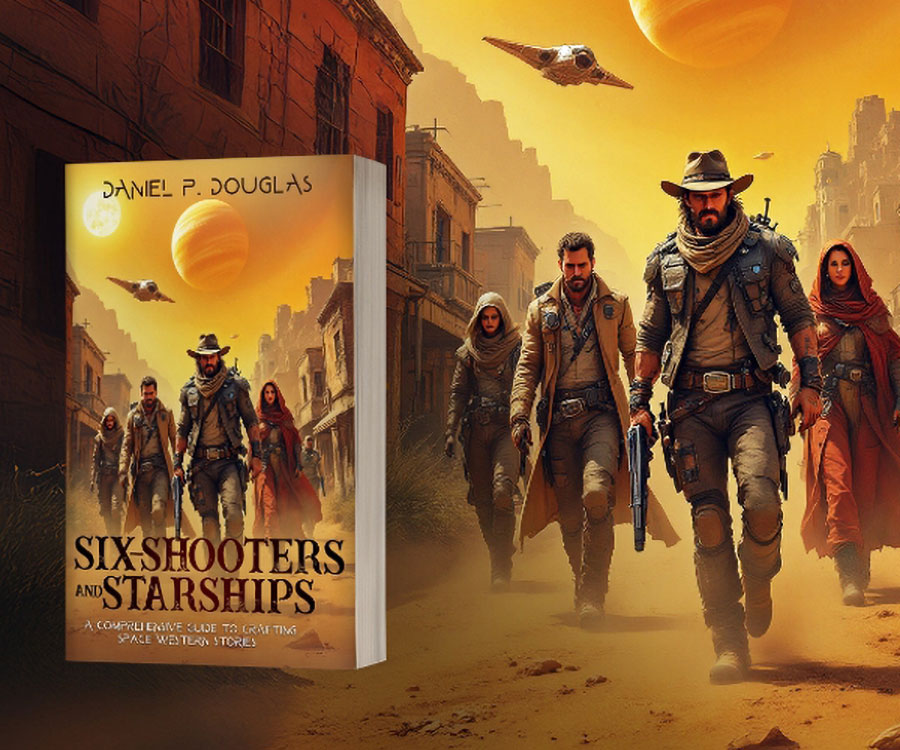Explore how my short story, “Seeds of Deception,” blends noir detective elements with space western tropes to create a narrative framework for science fiction storytelling.
Introduction
A lone specialist with specialized skills navigates a morally ambiguous frontier, encounters a mysterious stranger with hidden motives, and finds himself caught in a web of deception where powerful interests manipulate from the shadows. This could describe a Humphrey Bogart detective film or a Clint Eastwood western – but in the short story, “Seeds of Deception,” these classic narrative elements unfold across the colonized moons of Jupiter, creating what can best be described as a “Science Fiction Noir Space Western.”
This genre-blending approach has created some of science fiction’s most compelling narratives, from “Blade Runner” to “Firefly” to “The Mandalorian.” In this analysis, I’ll discuss how “Seeds of Deception” integrates elements from hardboiled detective fiction and classic westerns within its science fiction framework, and why this combination resonates so well with readers.
Background: The Convergence of Genres
The Noir Detective Tradition
Film noir and hardboiled detective fiction emerged in the early-to-mid 20th century, characterized by:
-
Morally ambiguous protagonists
-
Mysterious figures with hidden agendas
-
Urban settings with shadowy environments
-
Themes of corruption, betrayal, and manipulation
-
First-person or close third-person narration with cynical observations
The Western Genre Foundation
Western stories, set on the American frontier, typically feature:
-
Isolated protagonists with specialized skills
-
Frontier settings where civilization meets wilderness
-
Themes of justice outside formal legal structures
-
Moral codes developed by individuals in lawless territories
-
Confrontations that force ethical decisions
Science Fiction as the Perfect Canvas
Science fiction, particularly when set in space colonies or frontier planets, provides an ideal framework to blend these genres because:
-
Space represents a new frontier with incomplete governance
-
Corporations often replace traditional villains in power structures
-
Technology creates new methods of deception and discovery
-
Isolated environments mirror both the noir city and the western frontier
Section I: Noir Elements in “Seeds of Deception”
The Protagonist as Detective
How Zeph Garner embodies the classic noir protagonist:
-
Professional detachment that masks deeper principles
-
Specialized knowledge that separates him from ordinary citizens
-
Cynical worldview shaped by experience with corruption
-
Ability to navigate morally compromised situations
The narration emphasizes this detective sensibility: “Extraction specialists learned early to question motives, not morality.” This echoes the hardboiled detective’s pragmatic approach to a corrupt world.
The Femme Fatale Reimagined
How Tao Lin functions as a reimagined femme fatale:
-
Mysterious stranger who disrupts the protagonist’s plans
-
Possesses hidden knowledge that changes the protagonist’s perspective
-
Represents both danger and opportunity
-
Creates moral complications
Unlike the traditional femme fatale who often betrays the hero, Tao offers a “professional courtesy” that aligns with Zeph’s ultimate moral code, adding complexity to the archetype.
Corporate Corruption as Noir Conspiracy
The shadowy dealings between Santiago and the Mars Agricultural Consortium mirror noir’s preoccupation with systemic corruption:
-
Powerful interests manipulate from behind the scenes
-
Money drives betrayal and moral compromise
-
Information becomes a weapon and currency
-
The protagonist must navigate a system designed to use and discard him
The line “Santiago had engineered a contingency ensuring mission completion regardless of circumstances” captures the noir sense of inescapable entrapment by powerful forces.
Section II: Western Elements in “Seeds of Deception”
The Space Frontier as the New West
How Ganymede Colony functions as a frontier setting:
-
Three million people living on the edge of civilization
-
Limited law enforcement that can’t fully control the territory
-
Tension between corporate interests and frontier independence
-
Physical environment that presents constant danger
The description of Ganymede as “a frontier metropolis of pressurized domes and underground habitats” establishes this western landscape in space.
The Gunslinger’s Code
How Zeph exhibits traits of the western gunslinger:
-
Specialized skills that make him valuable and dangerous
-
Personal code that transcends legal structures
-
Reluctance to engage unless forced
-
Ultimate willingness to stand against corruption when pushed too far
Tao’s observation of his concealed weapon highlights this gunslinger identity: “Your right side hangs heavier, you’ve adjusted your position six times to accommodate the weight, and you maintain a three-inch gap between your arm and torso for draw clearance.”
Justice Outside the Law
The resolution embodies the western’s approach to frontier justice:
-
The protagonist takes matters into his own hands
-
Justice is delivered outside formal legal channels
-
The ending restores moral balance rather than legal resolution
-
Individual action trumps institutional processes
When Zeph uploads the research data to both Santiago’s server and a public hub while sending evidence to authorities, he enacts a classic western resolution where justice is delivered through personal action rather than institutional processes.
Practical Applications: Crafting Your Own Genre-Blending Fiction
Key Elements to Incorporate
To effectively blend genres in your own science fiction narratives:
-
Create a protagonist with specialized skills but moral ambiguity who must operate in systems they don’t fully trust
-
Establish a frontier setting that combines isolation with danger and limited governance
-
Introduce mysterious figures whose motivations remain unclear until pivotal moments
-
Develop power structures that operate in shadows, manipulating events for profit or control
-
Craft moral dilemmas that force characters to define their own ethical boundaries
-
Balance technological elements with universal human motivations
Common Pitfalls to Avoid
When blending noir and western elements in science fiction:
-
Don’t let technology overshadow character development
-
Avoid making your protagonist too heroic or too cynical
-
Remember that setting should inform character choices
-
Maintain believable motivations even in fantastic circumstances
-
Don’t sacrifice story coherence for genre expectations
Future Implications: The Evolution of Genre-Blending Narratives
The Continuing Appeal
The noir space western framework continues to resonate because:
-
It addresses timeless concerns about individual agency within corrupt systems
-
Space exploration represents our contemporary frontier
-
Corporate power increasingly parallels traditional noir villains
-
Technology creates new forms of isolation and connection
Emerging Trends
The evolution of this genre-blending approach may include:
-
Greater emphasis on information as both weapon and commodity
-
More complex moral territory as protagonists navigate competing loyalties
-
Integration of AI and posthuman elements that further complicate agency
-
Expansion beyond physical space to include virtual frontiers
Conclusion
“Seeds of Deception” hopefully demonstrates the powerful narrative potential created when noir detective elements blend with space western frameworks. By placing a morally complicated protagonist in a frontier environment controlled by shadowy interests, the story creates tensions and ethical dilemmas that resonate across genres.
The ending line captures this synthesis: “In the space between planets, the most dangerous weapons remained invisible—information, timing, and the well-placed word from a stranger on a routine shuttle flight.” Here we see noir’s emphasis on hidden knowledge combined with the western’s frontier setting and the science fiction framework that makes both possible.
For writers and readers alike, recognizing these genre patterns enhances our appreciation of stories like “Seeds of Deception” while providing tools to craft new narratives that explore the ethical complexities of future frontiers.
Read the complete story “Seeds of Deception” on Reedsy and see how these noir and western elements enhance the science fiction storytelling.





